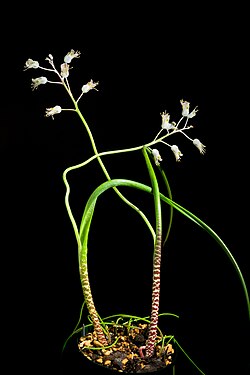Biology:Lachenalia unifolia
| Lachenalia unifolia | |
|---|---|

| |
| A cultivated banded viooltjie | |
| Scientific classification | |
| Kingdom: | Plantae |
| Clade: | Tracheophytes |
| Clade: | Angiosperms |
| Clade: | Monocots |
| Order: | Asparagales |
| Family: | Asparagaceae |
| Subfamily: | Scilloideae |
| Genus: | Lachenalia |
| Species: | L. unifolia
|
| Binomial name | |
| Lachenalia unifolia Jacq.
| |
| Synonyms[1] | |
| |
Lachenalia unifolia, the banded viooltjie, is the most common Lachenalia species in the Cape Floristic Region of South Africa .
Description
This bulbous geophyte grows 8–35 cm (3.1–13.8 in) tall.[2] It has one linear leaf, the lower part of which is banded with green and maroon stripes.[3] It is 8–32 cm (3.1–12.6 in) long and clasps the stem at the base.[2] The tuber contains a multi-layered tunic. The outer layers are dark brown and spongy while the inner layers are a translucent white colour.[2]
Flowers are present between August and October. They are pale blue, pink or pale yellow in colour with white tips.[3] They are borne in a raceme, which may have few or many flowers.[2]
The ellipsoid capsule contains glossy black spherical seeds.[2]
Distribution and habitat
This species is endemic to the Northern Cape and Western Cape of South Africa .[4] It is found on deep sandy flats and stony clay slopes between Namaqualand to Bredasdorp.[2]
Conservation
Lachenalia unifolia is the most common Lachenalia species and is considered to be of least concern by the South African National Biodiversity Institute (SANBI). While it is declining due to a combination of habitat loss and alien vegetation, the rate of decline is not currently considered high enough to put this species at risk of extinction.[4]
Uses
This species is valued as an ornamental plant.[5]
References
- ↑ "Lachenalia unifolia". Species. GBIF. http://www.gbif.org/species/2775378.
- ↑ 2.0 2.1 2.2 2.3 2.4 2.5 e-Flora of South Africa. v1.42. 2023. South African National Biodiversity Institute. http://ipt.sanbi.org.za/iptsanbi/resource?r=flora_descriptions&v=1.42
- ↑ 3.0 3.1 Manning, John; Goldblatt, Peter (2012). Plants of the Greater Cape Floristic Region : 1: the core Cape flora. Pretoria: South African National Biodiversity Institute, SANBI. ISBN 978-1-919976-74-7. OCLC 852384288. https://www.sanbi.org/sites/default/files/documents/documents/strelitzia-29-2012.pdf.
- ↑ 4.0 4.1 Duncan, G.D.; Mtshali, H. (2019). "Lachenalia unifolia Jacq. National Assessment: Red List of South African Plants version 2020.1.". http://redlist.sanbi.org/species.php?species=3814-4009.
- ↑ van Rooyen, P.; Spies, J.J.; Kleynhans, R. (2002). "THE SPECIES DELIMITATION OF LACHENALIA UNIFOLIA AND L. HIRTA". Acta Horticulturae (570): 395–401. doi:10.17660/ActaHortic.2002.570.56. ISSN 0567-7572. https://www.actahort.org/books/570/570_56.htm.
Wikidata ☰ Q15519814 entry
 |

